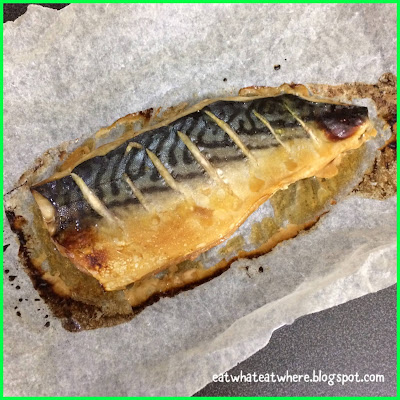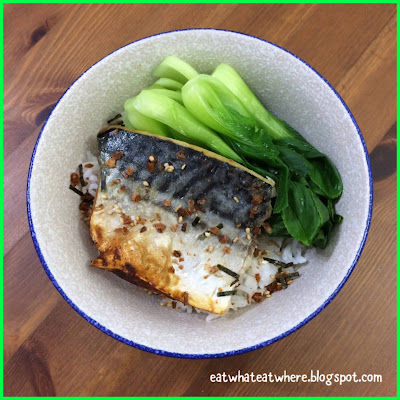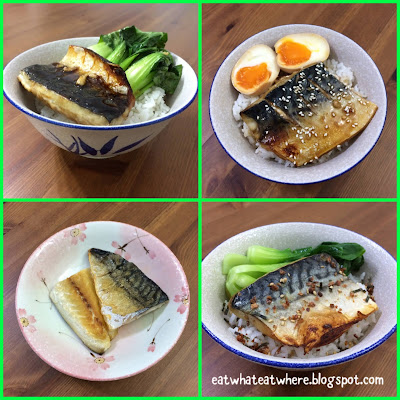I've always enjoyed eating unagi and saba at Japanese eateries. And since I can get a reliable supply of reasonably priced frozen seafood delivered to me via Vfresh now, I decided to get some to try. I've already tried (frozen) unagi previously and though the quality and taste was a distance away from what I had at Japanese restaurants, it's still a possible option if I'm looking for some very affordably priced unagi.
But their frozen saba is quite a different story. I first bought two fillets to try (one piece costs about RM5 - RM7 depending on stock or promotion) and enjoyed it so much that I got another three on my second order (and I foresee this will be a regular order from now on) which tasted even better (fresher stock, I think). Vfresh's saba sells out quite quickly (sometimes two weeks after re-stock, testament that they're pretty popular with his customers). Of course, one has bear in mind that this is frozen saba, so it wouldn't be fair to compare them with the fresh mackerel served at some Japanese restaurants.
I usually cook them in two ways.....the same two ways I've eaten them...and the only two ways I know how to cook them....lol. Recipe 1 is Saba Teriyaki or grilled mackerel in teriyaki sauce.
Shoyu (Japanese soy), sake (Japanese rice wine) and mirin (similar to sake but sweeter and with a lower alcohol content) are possibly three of the most common ingredients used in Japanese cooking that you'll need. But I don't carry sake in my pantry (I don't even use Japanese soy) since I rarely cook Japanese anyway. Japanese sauces and condiments are not cheap + they also tend to have very short shelf lives compared to our Chinese sauces so, unless you use them often, they'll expire before you're even half way through the bottle (and that has happened to me before). So, when recipes call for the use of sake, I sometimes substitute with Chinese rice wine (or Shaoxing wine) or omit altogether + I also use Chinese soy sauce in replacement of shoyu (otherwise I end up two types of soy that I can't finish). The only one that I do buy is mirin as it's used in practically all Japanese dishes.
A typical teriyaki sauce uses shoyu, sake and mirin in equal parts with added sugar (adjusted to your liking). The golden ratio is usually 2 : 2 : 2 : 1 and you can stick to this measurement depending on the amount you want to make (use a tablespoon if you're making just a bit and use a cup if you want to make more).
For my recipe (for one piece of saba), apart from 2 tbsp of mirin and 2 tbsp of Shaoxing wine, I used 1 tbsp of soy and 1 tbsp of water (instead of 2 tbsp of shoyu) as I know the soy sauce I have is quite salty (so adjust accordingly as only you know the intensity of your soy). And since I reduced the amount of shoyu, I could also reduce the amount of sugar from 1 tbsp to only 1/2 a tbsp. You can also choose to omit the Shaoxing wine (like I've done before) and it'll still be just as good.
Method 1 - Spoon 2 tbsp of the marinade over the fish and put to bake/grill in your convection oven. Most recipes online would advise you to set the temperature to 180°C and grill for about 15 - 20 minutes.
I decided to crank up the heat to 200°C (+ I also sprayed the saba with some olive oil) as I'm thinking this will give it a better charring and it was done in half the time (10 minutes). When it was taken out of the oven, I noticed that the belly section of the saba (the thinner part of the fish) curled up.
Simmer the rest of the teriyaki marinade to reduce to a thicker consistency for intensity of flavour. It should take no more than 2 - 3 minutes depending on the consistency you wish to achieve. This method obviously needs a little bit more effort (to reduce the sauce).
Method 2 - Marinate the saba with the teriyaki sauce and then put to grill/bake in the oven at 200°C (I poured the rest of the marinade over the fish). This is the much simpler way to prepare saba teriyaki.
I decided to make some slits in the fish this round and it didn't curl up this time. This time I cooked it for 8 minutes (anytime between 8 - 10 minutes is fine). But because the fish is wet (from the marination), you might get a bit less charring on the fish but a bit more flavour in the fish.
Also, if you choose to do it this way, the sauce (which was cooked along with the fish) will not have the intensity of colour nor flavour coz it was not reduced, so it'll also be more watery.
Recipe 2 is Saba Shioyaki or salt (shio) grilled (yaki) mackerel, the second and only other way I know how to cook saba fillets.
I like to keep the frozen mackerel dry by putting it between paper towels after it has been defrosted. I rubbed both sides of the fish with some olive oil and sprinkle the fish (skin side) with salt. The flesh side of the fish, I used less salt but rubbed a tiny bit of light soy on it hoping that it would help brown the fish better.
I put it into the oven (skin side down) at 200°C and decided to put the tray on the upper level of the oven (nearer the heat). I grilled the underside for about 5 minutes before flipping the fish over and grilling the skin side for a further 5 minutes. The skin that was brushed with oil, I was hoping would crisp up and char...and it did, but not entirely.
You can also choose to pan-fry your saba shioyaki which will give rise to a much crispier skin and a more browned fish overall. But it can also turn out a little drier, so try to use the grilling/baking method instead of pan-frying for a moister finish.
You can serve this grilled saba shioyaki as a side dish on its own. It's beautiful with a squeeze of fresh lemon juice over it. ^o^ Simple but yet so good...but don't expect the skin to be too crispy though as saba fish is known to have slightly chewy skin. Sprinkle some furikake over the top just because you can...lol.
Or make it into a donburi with steamed rice and some greens (I usually do it with either stir-fried or blanched bok choy). I'm pretty pleased with the quality and taste of this frozen saba...certainly way better and not as dry as those grilled mackerel bentos I used to get from Aeon (and even better than some of those from Japanese and Korean restaurants).
For those of you who like your saba with a sauce and some sweetness, then the saba teriyaki will appeal to you more. Great eaten on its own too. But I'd probably go with the method which needs a little bit more effort as the reduced teriyaki sauce will have a more concentrated flavour (tweak the sweetness of the sauce to suit your palate). ^.^
The only thing that's missing is that great smoky, charred flavour like those you get at Japanese restaurants. I'm afraid that can only happen if the saba is grilled on an open flame, over hot charcoal, that will blister the skin and impart that much sought after charred flavour into the flesh.
Whether eaten teriyaki or shioyaki-style, it's good either way. ^o^ Though the skin can be a little chewy and the flesh just a tad dry (sometimes depending on the quality and freshness of the saba), we can't ask for more really for a fish that's that cheap. I like it for its rich, oily flavour but some might find it a bit too fishy, or strong, not me though.
As the fish fillet is relatively thin, it defrosts quite quickly too, so it's a pretty handy thing to have in the freezer that one can use to cook at short notice (such as during a rainy day in New York....oops, I mean KL!). Just 8 - 10 minutes in the oven is all it needs to have a quick and healthy meal ready...and that sounds pretty darn good to me. Go get some frozen saba! ^_~



















I will buy frozen Saba Fish on and off but I can't say I really like it because it can be quite fishy sometimes (maybe because of the freshness of the fish was not good) and the texture tend to be quite dry after being cooked.
ReplyDeleteAs the saba fillet is a very thin piece of fish, the key is to not cook it for too long so that it doesn't dry out. The ones I get from this supplier I don't find it fishy or (perhaps) marinating it in mirin helped. ^_~
DeleteNot Teriyaki sauce on fish, I find it strange to my palate. In fact I find teriyaki sauce on anything other than chicken as strange. Probably is my own problem.
ReplyDeleteI'm the exact opposite...I actually prefer teriyaki on fish (especially salmon) rather than chicken. :P
DeleteAh! Saba is a favorite of my partner's and you will find him ordering this at the Japanese restaurant (with chicken karaage as a side dish) without fail. We usually pan fry it. I have also grilled it in the oven but prefer not to because it makes my oven smell hah..hah... I also bought saba from Vfresh and I still have some in stock in the freezer. I have yet to cook it with teriyaki sauce. Since I have mirin in my pantry I might give it a go during the Hari Raya holidays.
ReplyDeleteYour partner's liking for saba makes it very easy to cook this at home for him. After trying out both methods, I realised that cooking it in the oven is not as dry as pan-frying. Luckily for me, I don't feel that it makes my oven smell (I'm assuming you meant fishy smell). I think the oven would smell like the very food you cooked irrespective of what kind of food, so I just let the oven door ajar for a while to let the smell dissipate...hee..hee. Ya, try the saba with teriyaki as I feel that's the best way to eat the fish to make it feel not so dry. ^_~
DeleteWoW! You are such an excellent Japanese Shefu for sharing all the meticulous details and photos with matching plate. I salute your patience to make readers excited and happy to read this post.
ReplyDeleteI am a long time fan of unagi but I have not tried Saba yet. I will do so on my next visit to the Japanese restaurant. I just watched a documentary over Netflix about the fish market in Tokyo where they happened to show a lot about the Unagi eels. I was speechless to hear about the expensive ones served in Japan. Now I understand why I avoided eating Unagi in Japan as I went to the wrong places to eat them. Upscale areas like Ginza and Roponggi only serve the prized Unagis that are same ranks with Kobe Beef. One eel could cost up to RM500!
What?...RM500 for unagi *pengsan already* Such a pricey one must be really, really good. If at that price, I think I'd rather eat their beef instead. Here, I reckon RM200 can get you very good quality unagi already (my not-so-atas taste bud, I'm already satisfied with RM50 - RM100 unagi). Haha, saba is cheap...and cost only a tiny fraction of unagi! :D
DeleteHey, I'm no Japanese sifu lah...what I cooked here is the simplest of Japanese cooking which everybody can do...with frozen fish that a Japanese sifu will cringe at...lol! ^_~
Saba fish is nice, but I want fish from sabah!!!!!!
ReplyDeleteLike the Sabah giant grouper? ;)
Delete